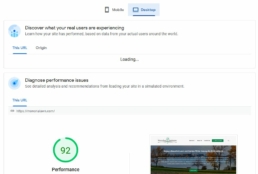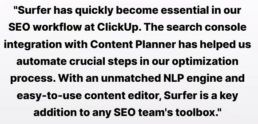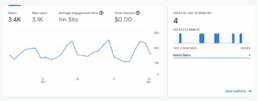If you’ve ever wondered, “What is a Good Website?” Then this is the article for you. There are many factors that go into making a good website. In this post, we will discuss 10 of the most important ones. Having a well-designed and user-friendly website is essential for any business. If you are not sure where to start, or if your website could use some improvement, keep reading! We will cover everything you need to know about creating a successful website.
What Makes a Good Website?
There are over 133 million websites in the United States, so standing out is essential to making your website successful. There are tons of factors that determine the quality of your website including load times and delivering a well crafted message. But what makes a good website stand out from the rest?
The most important factor to consider is making your customers happy by making their experience with your website convenient. If they are not happy with your website, they will not come back or bother to interact with your company. No one likes to deal with a website that is difficult to navigate, has slow load times, or is not user-friendly.
In fact, many consumers will determine whether they want to work with you based on your website. If it is not up to par, they will move on to the next business. Consumers have literally millions of options, so you have to make sure your website is one of the best if you want them to choose you.
15 Important Factors to go From a Good Website to a Great Website
In order to make sure your site leaves a good impression on your customers and stands out from the rest, you should consider the following 15 factors:
#1: Search Engine Optimization


Search engine optimization (SEO) is the process of optimizing your website to rank higher in search engine results pages. This means that your website will show up higher in Google results when people are looking for information related to your business.
SEO is important because it helps potential customers find your website. If they cannot find you, they cannot buy from you! In order to rank higher on a variety of search engines (Bing, Google, etc.), you will need to use the right keywords and optimize your website’s content and structure.
In addition to keyword research and content creation, you can also improve your website’s ranking by building backlinks, which are links from different websites that point to yours. The more high-quality backlinks you have, the higher your website will rank in search results pages.
SEO is an intensive process with numerous steps, but it is essential to making your website great. After all, a website that doesn’t attract visitors won’t perform for your business.
#2: Mobile Responsiveness


A great website provides content in the format users want to see it. In other words, your website should be mobile responsive. This means that the layout of your website will change depending on the device it is being viewed on.
If your website is not mobile responsive, it will look terrible when users view it on their phones or tablets. This is because the content will be crammed into a small view port instead of being displayed as you intended when building it.
Mobile friendly websites are essential to reaching users today. Over 60% of all search traffic comes from mobile devices. However, nearly half of small businesses don’t have a mobile friendly website, so you will stand out from the competition by creating a responsive website.
In order to make your site mobile responsive, you will need to use a responsive design template or hire a web designer who specializes in creating mobile-friendly websites.
#3: Customer Experience
If you have ever tried calling local businesses for a quote and waited for a call back for weeks, you know how frustrating poor customer service can be. Just like poor customer service, a poor customer experience will cost you potential customers. Inconveniencing customers will only drive them away from your website. According to a study by Forrester, 86% of customers will never return to a website after a bad experience.
Customers expect your website to be easy to use and navigate. They also expect it to contain all of the information they need to make a decision or purchase. If your website does not meet these expectations, customers will leave. In today’s fast paced economy, consumers don’t want to waste time calling several service providers to get information their website should already contain. Would you order tickets from a concert venue if you had to order over the phone? Not everyone would, especially when better options are available.
Learn More:
#4: Website Security


In today’s digital age, it is essential to have a website that is secure. This means that your website’s data is protected from hackers and other online threats. If your website is not secure, you run the risk of having your customers’ personal information stolen. In addition, you could also lose money if someone hacks into your website and steals your customers’ credit card information.
There are a number of ways to make your website more secure. You can start by using a strong password, adding an SSL certificate, and using security features such as two-factor authentication. You should also use a secure hosting provider, which will help to protect your website from online threats.
Don’t settle for an insecure website. If you fail to protect your customers, your company can be held liable for any damages that occur. So make sure your website is secure to keep your customers and your business safe.
Learn More:
#5: Page Speed


Page speed is another important factor to consider when creating a website. Remember a good customer experience is an essential part of what makes a good site. If your pages take too long to load, users will leave your website. According to a study by Google, 53% of mobile users will leave a website that takes more than three seconds to load. In addition, 47% of users expect a web page to load in two seconds or less.
There are a number of ways to improve your website’s page speed. You can start by optimizing your images, minifying your code, and using a content delivery network (CDN). You can also enable caching on your website.
If you aren’t sure where to start, be sure to contact a professional web design or development agency that can help with the technical aspects. If you are using WordPress or similar content management system (CMS), there a tons of plugins that can help improve the speed of your site.
#6: Site Structure


Make sure your website has a well designed structure. Not only does it aid in user navigation, but it impacts your site’s SEO efforts. A well designed structure also makes it easier for bots to crawl and index your website. This will help improve your site’s ranking in search engine results pages (SERPs).
You should also make sure your website has a sitemap. A sitemap is an XML file that contains a list of all the pages & posts on your website. This file helps search engines crawl and index your website.
Your website’s structure should be easy to understand and follow. It should also be consistent throughout the website. Users should be able to understand how each pages fits into the greater overall structure of your site.
#7: Use Social Proof


As mentioned above, there are over 130 million websites in the United States alone. This means that your website is competing for attention against millions of other websites. In order to stand out from the crowd, you need to generate trust from your users. One simple method of doing this is using social proof.
Social proof is the psychological principle that states people are more likely to do something if they see others doing it. Social proof on a website can take several forms including testimonials, reviews, and social media icons.
If you have ever seen a website with no list of previous customers or reviews of their service, then you know what I am talking about. This is a surefire way to make users question the legitimacy of your website. When users see that others have had a positive experiences with your business, they are significantly more likely to trust you and convert into customers.
#8: Branding
Make sure to keep your website branding consistent with your offline branding. This helps to create a unified brand experience for your users. In addition, it helps reinforce the idea that your business is legitimate and trustworthy.
Your website’s branding should be consistent with your company’s logo, colors, fonts, and overall design scheme. This will help to create a cohesive user experience across all of your marketing channels. If you aren’t sure how to do this yourself, consider hiring an artist for some graphic design work.
A great artist should be able to help you create a style guide for your branding that can be used as a reference for all future design work. This will ensure that your branding is always consistent, no matter who is working on your website.
#9: Analytics


Understanding how users interact with your site is critical to its success. This is where Google Analytics comes in. Google Analytics is a free web analytics service offered by Google. It allows you to track how users interact with your website, including what pages they visit and how long they stay on each page.
Using analytics data, you can make changes to your website that will improve user engagement. You can also use it to track your website’s performance over time. This data is essential for understanding how well your website is performing and what changes need to be made in order to improve it.
An analytics service is essential to any serious website owner. If you don’t know where your website is falling short, you can’t hope to correct the problems. There is an enormous amount of data available to website owners. Don’t guess what the problem is, use data to find out.
#10: Quality Content
Fresh content is the lifeblood of any website. If you don’t update your website on a regular basis, it will quickly become stale and irrelevant. This is especially true from an SEO perspective. New content tells Google that your website is still active and relevant.
Although posting regularly is essential to SEO, don’t sacrifice the quality of your content. Poorly written articles, copied content, and spammy links will only hurt your site’s reputation.
Focus on creating high-quality content that is useful and relevant to your audience. This will help you attract more visitors and keep them coming back for more. Although creating great content sounds complicated, it doesn’t have to be. Just take the time to write well and make sure your content is original.
Learn More:
#11: Calls to Action


Your website should always include clear and concise calls to action. A call to action (CTA) is an instruction to the user telling them what they should do next. For example, “click here to learn more” or “subscribe now for discounts”.
CTAs are essential for guiding users through your website and converting them into customers. Often site visitors will know what they want to do, but they need a little help getting there. CTAs help to bridge that gap and make it easy for users to take the next step.
Make sure your CTAs are clear and easy to see. They should also be relevant to the page on which they appear. If you’re asking users to sign up for your email list, don’t put a CTA for buying a product on the same page. Keep your CTAs simple and to the point. Users shouldn’t have to guess what you want them to do. Just tell them what you want them to do and make it easy for them to do it.
#12: Accessibility
Make your website accessible to everyone, regardless of their ability. There are millions of users out there that struggle to use certain sites because they aren’t designed with accessibility in mind. This means that your website should be designed in a way that is easy to use and navigate, regardless of the user’s level of disability.
There are many different ways to make your site more accessible. Some things you can do include using clear and concise text, picking colors with contrast, using large fonts, and adding alt text to your images. You can also use headings and lists to help organize your content, which is also useful for search engine optimization.
Making your website accessible is the right thing to do, and it’s also good for business. Accessible websites are easier to use and navigate, which means they are more likely to convert users into customers. Don’t neglect this important detail when redesigning your website.
#13: Navigation
Your website’s navigation is one of the most important aspects of your site. If users can’t find what they’re looking for, they’ll leave your site in a hurry. This is why it’s essential to have a clear and concise navigation system that is easy to use.
Make sure your navigation is easy to see and use. Think of clean menu bars that appear on many well designed sites. It should also be mobile-friendly, so users can easily navigate your site from their smartphones and tablets. Don’t bury your navigation in a sea of text.
Although helping users find the page they are looking for it important, don’t over crowd your menu bar with less relevant pages. Only include the pages that are most important to your users. You can always add more pages to your site’s footer section if needed, but don’t overwhelm users with too much information at once.
#14: Landing Pages
A landing page is a standalone web page that is designed to achieve a specific goal. This could be anything from getting users to sign up for your email list, to buying a product, or downloading a white paper.
Landing pages are essential for any website because they help you achieve your business goals. They are also great for driving traffic to your site. When users see an interesting offer or a call to action on a website, they often click through to the landing page to learn more.
Make sure your landing pages are well designed and easy to use. They should also be relevant to the offer or call to action that brought users there in the first place. If you’re offering users a free download in exchange for their email, the landing page should be dedicated to that free download. If you’re asking users to buy a product, the landing page should be dedicated to that product. Keep your goals and intentions clear, and make it easy for users to take action.
#15: Clear Message
Your website’s message should be clear and concise. It should also be relevant to your business and the goals you are trying to achieve. If users can’t figure out what your website is about within seconds, they will leave it in search of a site that is more clear.
You should use additional media such as images and videos that support your message and help explain it to users. Often users need this additional media to help them understand what you’re trying to say. If your website is all text, users will get bored quickly and leave.
That brings us to the end of our 15 important factors to consider when designing a great site. Keep these things in mind when creating or redesigning your website, and you’re sure to see improved results.
Frequently Asked Questions
Even though we’ve outlined some important factors to consider when designing a great site, you may still have some questions. Here are some of the most common questions we hear from our clients.
Do I need to redesign my site entirely?
No, you don’t need to redesign your entire site. In many cases, a simple redesign of the home page and key pages will do the trick. If your website is dated or doesn’t look professional, it’s probably time for an overhaul.
Our agency recommends redesigning your site every two to three years to keep it looking fresh and relevant. This also help ensure your site is up-to-date with the latest design and development trends. Remember technology moves quickly. If you don’t stay on top of changes, your website will get left behind.
How does a good website help search engines index my site?
A good website will help search engines index your site correctly. This means making sure the technical aspects of SEO are taken care of, such as using the correct meta data, titles, and descriptions. It also means having a site that is easy to crawl and index.
If you’re not sure how well your website is performing from an SEO standpoint, we suggest hiring an SEO expert to audit your site and make recommendations. Often small changes can make a big difference in performance.
If you are searching for someone to help audit your website, contact our team for a free website audit. We will leave you will actionable tips to improve your website’s SEO. In fact, many of our clients have seen significant increases in website traffic and organic search traffic after making just a few basic changes to their site.
Can social media platforms help improve my site?
Yes, social media platforms can help improve your website. In fact, they can be a great way to drive traffic to your site and improve interactions. However, you need to use them correctly or they can actually hurt your efforts.
Social media can help distribute your content and increase brand awareness. For instance, you should create social media accounts for your business and populate them with relevant content. If your followers find the content useful they might share it and this will creates social media links back to your site. Users may decide to follow the link back to your site, which will generate organic social traffic!
Lastly, be sure to add social media share buttons to your site so users can easily share your content with their friends and followers. This is another simple way to improve your websites usability, while helping increase your content distribution.
Wrapping Up
In closing, a good site is one that is professional looking, easy to use, and helps you achieve your business goals. It’s important to take the time to consider all of the factors involved in designing a good site. By following our tips, you can create a site that is both effective and appealing to users. If you found this article helpful, please share it with your friends and followers!
Looking for Help Making Your Website Great?
If you are seeking a professional team to help you design or redesign your website, our agency can help. We offer a wide range of services that will help you create a site that is both effective and appealing to users including search engine optimization, website design, & managed WordPress hosting. If you have any questions, please don’t hesitate to contact our team. We are always happy to help!
